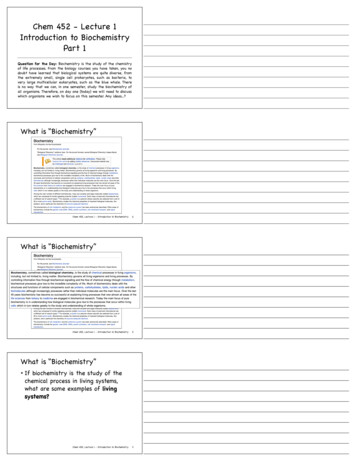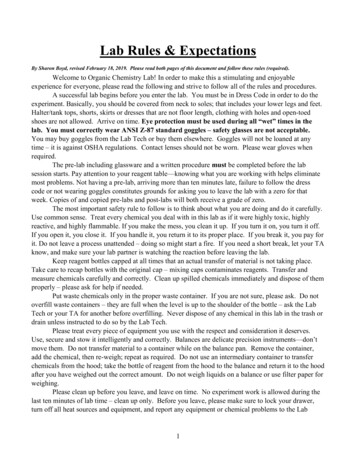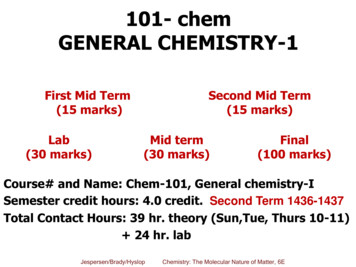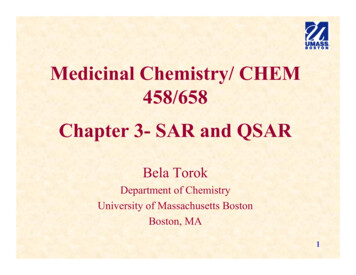
Transcription
Chem 452 - Lecture 1Introduction to BiochemistryPart 1Question for the Day: Biochemistry is the study of the chemistryof life processes. From the biology courses you have taken, you nodoubt have learned that biological systems are quite diverse, fromthe extremely small, single cell prokaryotes, such as bacteria, tovery large multicellular eukaryotes, such as the blue whale. Thereis no way that we can, in one semester, study the biochemistry ofall organisms. Therefore, on day one (today) we will need to discusswhich organisms we wish to focus on this semester. Any ideas.?What is “Biochemistry”Chem 452, Lecture 1 - Introduction to Biochemistry2What is “Biochemistry”Chem 452, Lecture 1 - Introduction to Biochemistry2What is “Biochemistry” If biochemistry is the study of thechemical process in living systems,what are some examples of livingsystems?Chem 452, Lecture 1 - Introduction to Biochemistry3
Biology is Varied and ComplexChem 452, Lecture 1 - Introduction to Biochemistry4Biology is Varied and ComplexQuestion for the Day: Biochemistry is the study of the chemistryof life processes. From the biology courses you have taken, you nodoubt have learned that biological systems are quite diverse, fromthe extremely small, single cell prokaryotes, such as bacteria, tovery large multicellular eukaryotes, such as the blue whale. Thereis no way that we can, in one semester, study the biochemistry ofall organisms. Therefore, on day one (today) we will need to discusswhich organisms we wish to focus on this semester. Any ideas.?Chem 452, Lecture 1 - Introduction to Biochemistry4Biology is Varied and ComplexChem 452, Lecture 1 - Introduction to Biochemistry4What is “Biochemistry” How can we possibly study all ofthese livings systems?Chem 452, Lecture 1 - Introduction to Biochemistry5
What is “Biochemistry” How can we possibly study all ofthese livings systems?Chem 452, Lecture 1 - Introduction to Biochemistry5What is “Biochemistry” How can we possibly study all ofthese livings systems?Chem 452, Lecture 1 - Introduction to Biochemistry6Biology is Varied and Complex At the molecular level, living systemslook remarkably similar. This similarity is a reflection of how lifeevolved on earthChem 452, Lecture 1 - Introduction to Biochemistry7Biology is Varied and Complex At the molecular level, living systemslook remarkably similar. This similarity is a reflection of how lifeevolved on earthChem 452, Lecture 1 - Introduction to Biochemistry7
Biology is Varied and Complex At the molecular level, living systemslook remarkably similar. This similarity is a reflection of how lifeevolved on earthChem 452, Lecture 1 - Introduction to Biochemistry7Biology is Varied and Complex At the molecular level, living systemslook remarkably similar. This similarity is a reflection of how lifeevolved on earthChem 452, Lecture 1 - Introduction to Biochemistry8Biology is Varied and Complex At the molecular level, living systemslook remarkably similar. This similarity is a reflection of how lifeevolved on earthChem 452, Lecture 1 - Introduction to Biochemistry8Biology is Varied and Complex At the molecular level, living systemslook remarkably similar. This similarity is a reflection of how lifeevolved on earthChem 452, Lecture 1 - Introduction to Biochemistry8
Biology is Varied and Complex At the molecular level, living systemslook remarkably similar. This similarity is a reflection of how lifeevolved on earthChem 452, Lecture 1 - Introduction to Biochemistry8Biology is Varied and Complex At the molecular level, living systemslook remarkably similar. This similarity is a reflection of how lifeevolved on earthChem 452Chem 452, Lecture 1 - Introduction to Biochemistry8Biology is Varied and Complex At the molecular level, living systemslook remarkably similar. This similarity is a reflection of how lifeevolved on earthChem 454Chem 452, Lecture 1 - Introduction to Biochemistry8Biology is Varied and Complex At the molecular level, living systemslook remarkably similar. This similarity is a reflection of how lifeevolved on earthChem 452, Lecture 1 - Introduction to Biochemistry8
Biology is Varied and Complex Biochemistry unifies biology Macromolecules and metabolitesChem 452, Lecture 1 - Introduction to Biochemistry9Biology is Varied and Complex Biochemistry unifies biology Macromolecules and metabolitesArchaeaChem 452, Lecture 1 - Introduction to Biochemistry9Biology is Varied and Complex Biochemistry unifies biology Macromolecules and metabolitesArchaeaEukarya (Plant)Chem 452, Lecture 1 - Introduction to Biochemistry9Biology is Varied and Complex Biochemistry unifies biology Macromolecules and metabolitesArchaeaEukarya (Plant)Eukarya (Animal)Chem 452, Lecture 1 - Introduction to Biochemistry9
A brief history of Biochemistry Fredrich Wöhler(1800-1882) Demonstrated in 1828 that urea,a compound that had only beenassociated with living cells, couldbe synthesized from an inorganiccompound outside of the cell.ONH4 NCO H2NammoniumcyanateCNH2ureaChem 452, Lecture 1 - Introduction to Biochemistry10A brief history of Biochemistry Predict and compare the physicalproperties of ammonium cyanate andurea.ONH4 NCandOH2NammoniumcyanateCNH2ureaChem 452, Lecture 1 - Introduction to Biochemistry11A brief history of Biochemistry Outcomes for this semester include: Apply your knowledge of general and organicchemistry to predicting the structures and interactionsof biological molecules from their elementalcompositions and structures.Develop an understanding of how the chemicalstructures and physical properties of biologicalmolecules relate to their function.Develop an understanding of how biological moleculesinteract with one another to produce complex, selfregulating systems, and how chemical energy is utilizedto drive and sustain these processes.Chem 452, Lecture 1 - Introduction to Biochemistry12A brief history of Biochemistry Fredrich Wöhler(1800-1882) Demonstrated in 1828 that urea,a compound that had only beenassociated with living cells, couldbe synthesized from an inorganiccompound outside of the cell.ONH4 NCammoniumcyanateO H2NCNH2urearxn animationChem 452, Lecture 1 - Introduction to Biochemistry13
A brief history of Biochemistry Roll forward to 2009 (181 years later) We can now view the steps of proteinsynthesis by ribosomes at the atomic levelBlaha et al., “Formation of the First Peptide Bond: The Structure of EF-P Bound to the70S Ribosome” Science 2009, 325, 966-970.Chem 452, Lecture 1 - Introduction to Biochemistry14A brief history of Biochemistry Nobel Prize in Chemistry, 2009Nobel Prize Committees News ReleaseChem 452, Lecture 1 - Introduction to Biochemistry15Using Jmol to view structures Styer’s companion website (6th Ed.)and “Living Figures”Figure 2.40 A protein rich in βsheets. The structure of a fatty acidb-binding proteins [Drawn from1FTP.pdb]Chem 452, Lecture 1 - Introduction to Biochemistry16Looking ahead to Friday, 7. Sept Review DNA structure and function Review non-covalent interactions. Review the properties of water and thehydrophobic effectReview ThermodynamicsChem 452, Lecture 1 - Introduction to Biochemistry17
Looking ahead to Friday, 7. Sept Problem Assignment for Chapter 1Question of the Day: Watson and Crick madethe following observation in their landmarkarticle, which was published in 1953 in thejournal Nature, “It has not escaped our notice that thespecific pairing we have postulatedimmediately suggests a possible copyingmechanism for the genetic material.” What are they talking about?Chem 452, Lecture 1 - Introduction to Biochemistry18
Chem 452, Lecture 1 - Introduction to Biochemistry Biology is Varied and Complex 7 At the molecular level, living systems look remarkably similar. This similarity is a reflection of how life evolved on earth Chem 452,










